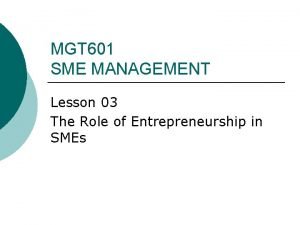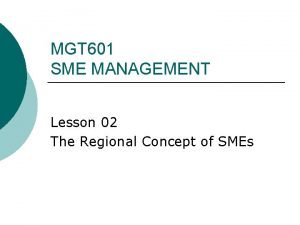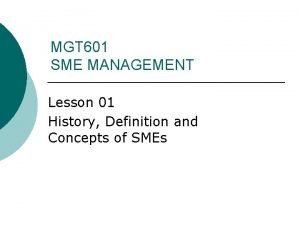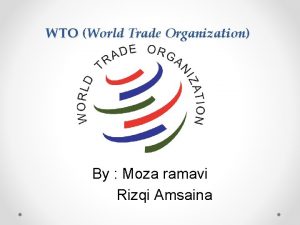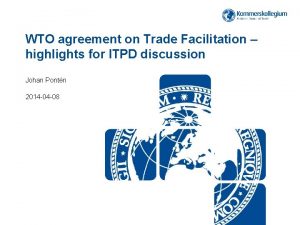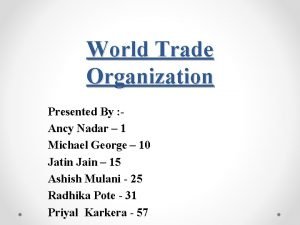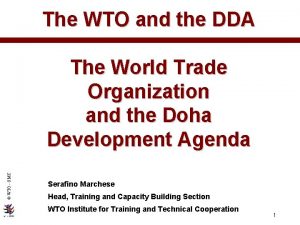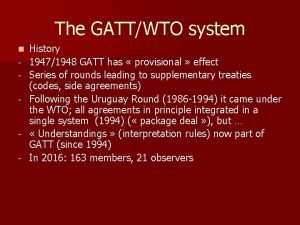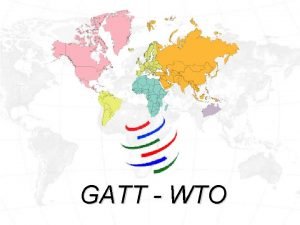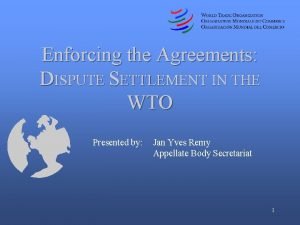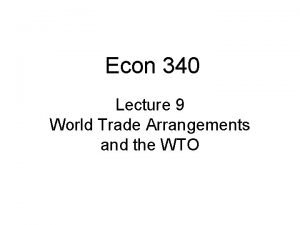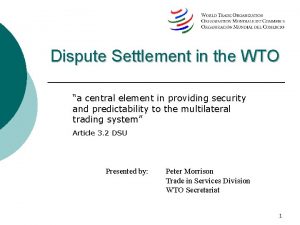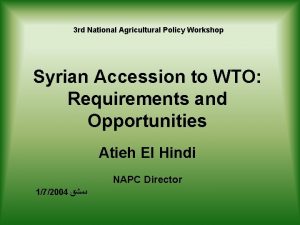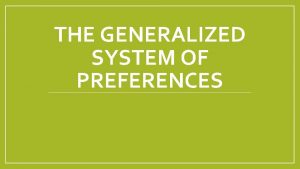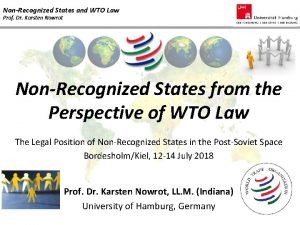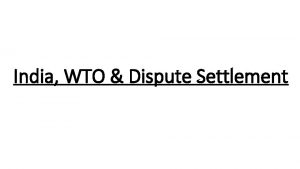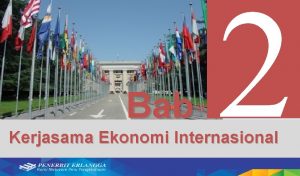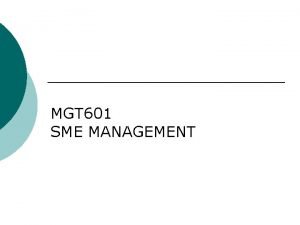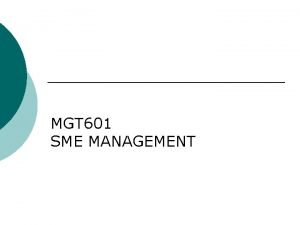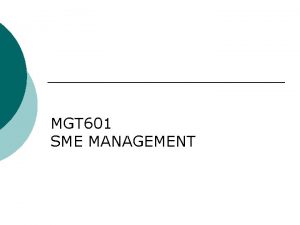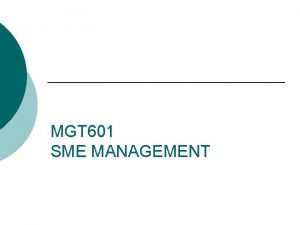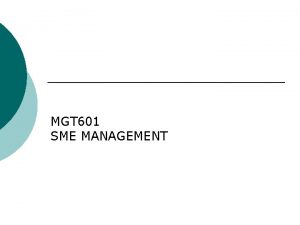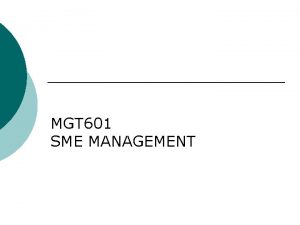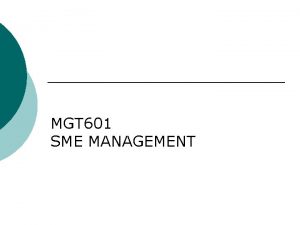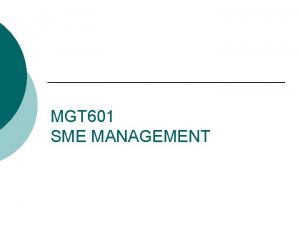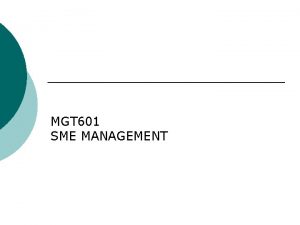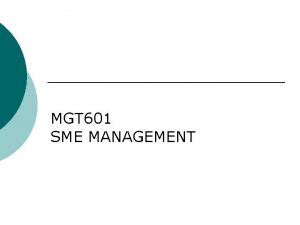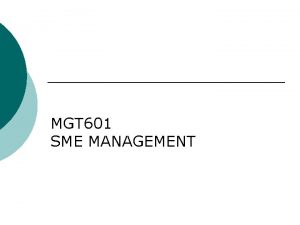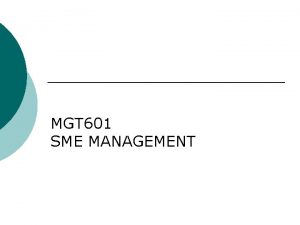MGT 601 SME MANAGEMENT Lesson 43 Pakistan WTO

















- Slides: 17

MGT 601 SME MANAGEMENT

Lesson 43 Pakistan & WTO – III

Chapter Learning Objectives This Lecture deals with; ¡ WTO Agreements on TBT and SPS ¡ Role of Exporters in tackling Non Tariff Barriers ¡ Impact of Reduction of Tariff and NTBs by Developed Countries

WTO Agreements on TBT and SPS ¡ To meet the requirements of WTO Agreements on Technical Barriers of Trade (TBT) and Sanitary and Phytosanitary Standards (SPS), Pakistan has taken a number of key initiatives aimed at strengthening technical institutions capabilities in standard setting, compliance.

Continued…. ¡ ¡ ¡ In Pakistan, ISO 9000 – and ISO 14000 certification is rising and reportedly now well over 3, 000 companies are ISO 9000 certified. As for ISO 14000 certifications, out of a total of 103 countries, Pakistan ranks 56 th with only ten ISO 14001 certified firms while India is 19 th. All these companies are certified by foreign based bodies

Continued…. ¡ Against this backdrop, Pakistan National Accreditation Council (PNAC) was set up in 1998 in Ministry of Science & Technology and in 1999, under ADBassisted Trade Export Promotion & Industry Program (TEPI). Project, it launched the accreditation services for ISO 9000/ISO 14000 certification bodies and ISO-17025 laboratory certification.

Continued…. ¡ According to Pakistan Country Report on Trade and Sustainable Development, prepared by Sustainable Development Policy Institutes (SDPI), in October 2002, the TBT and SPS agreements present both an opportunity and constraints. The two agreements seek to increase market access for the exports of its member countries.

Role of Exporters in tackling Non Tariff Barriers ¡ Some of non-tariff barriers can be tackled by the exporters themselves by ensuring that they adhere to quality and standards requirements of the importing countries. For this purpose they need to plan production and packaging methods especially for the export markets.

Continued…. ¡ The manufacturing techniques must be carefully selected so as to insure that the resultant products do not cause any harm to human, animal or plant life or health.

Continued…. ¡ The exporters need to carefully study the laws and regulations of the importing countries and their likely impact on the exports. similarly they should also carefully examine the notices or notification made by the importing countries under the Agreement on Application of Sanitary and Phytosanitary measures and the Agreement on Technical Barriers to Trade.

Continued…. ¡ The exporters should maintain an effective interaction with their counterpart associations etc. in the importing countries. Any difficulties due to technological or economical limitations must be adequately brought forward to the notice of the Government. Most of the WTO Agreements envisage special and preferential treatment to developing countries.

Continued…. ¡ Specific problems being faced and the favours required should therefore, be identified. This may help the Government to have effective bilateral consultations with the concerned countries and to seek specific dispensation.

Continued…. ¡ Since any dispute in the WTO can be raised by the Governments only, the exporters will do well to fully cooperate with their Government and to provide it with all the necessary information through their associations.

Impact of Reduction of Tariff and NTBs by Developed Countries ¡ Developed countries committed to a 40 percent reduction in the average tariff on industrial products from 6. 2 percent to 3. 8 percent. While these cuts will improve access, their impact has been small because tariffs on manufactures in industrial countries were already low (except apparel). Pakistan’s exports to OECD will face average rates of 6. 9 percent.

Continued…. ¡ However, textile and clothing products, which account for 57 percent of our exports to OECD received below average tariff reduction of 22 percent, meaning that developed countries will reduce tariffs from 14. 6 percent to 11. 3 percent. Exports of leather products and travel goods are also important to Pakistan but this again received below average 18 percent tariff reduction.

Continued…. ¡ After the complete phase out of quota restriction is feared that developed countries would resort to use of NON-Tariff Barriers like imposing requirement of environment and labour standards and use of child labour etc. to protect their own interests.

Thanks you Happy Learning, Keep Learning
